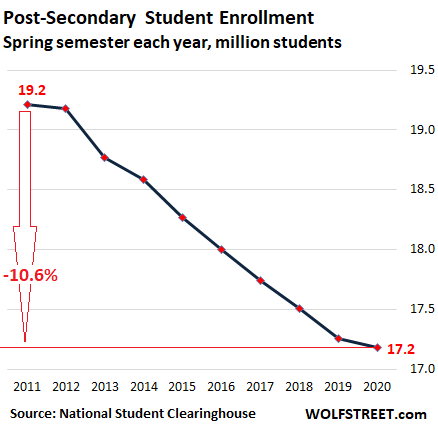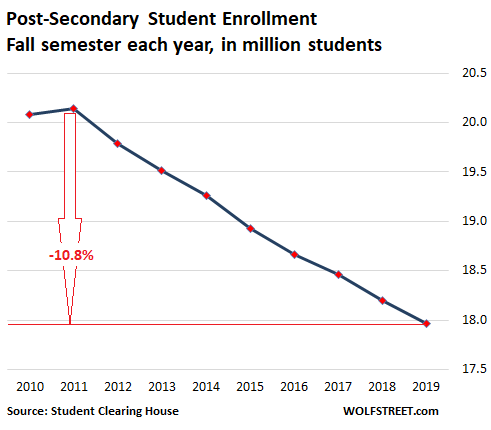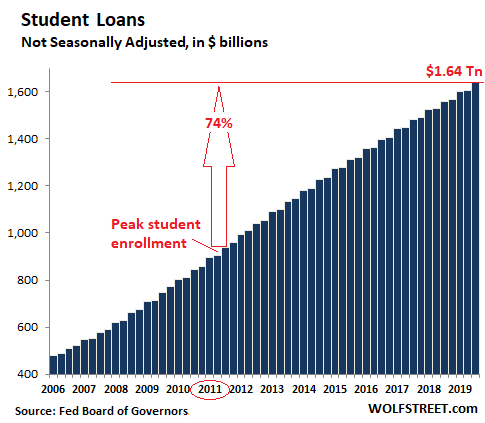The Daily Escape:

New Navajo Falls, Supai, AZ – 2020 photo by wanderin-wally. These falls were formed by a flash flood in 2008.
Colleges and universities are scrambling to figure out what to do this fall if their students can’t return to campus. Some students are reconsidering going to college. If they don’t return, what will happen to schools that are tuition-dependent?
Even before the pandemic hit, student enrollment for the spring 2020 had fallen for the ninth year in a row. Wolf Richter reports that the number of post-secondary students fell by more than 83,800 students (-.05%) to 17.18 million students. Worse, compared to the spring semester in 2011, enrollment is down by 10.6%, or 2.03 million students. Here’s Wolf’s chart:

Demo Memo says that college enrollment in the United States peaked in 2010 at just over 21 million, and as the chart shows, it has drifted downward ever since. For 2020s spring semester enrollment declined in all sectors compared to spring 2019:
- Public two-year: -2.3%
- Private for-profit four-year: -1.9%
- Private nonprofit four-year: -0.7%
- Public four-year: -0.6%
Public two-year schools have seen a 25% drop in enrollments since 2011, while enrollment in private for-profit colleges is down 55.2% for the same period. The drop in for-profit enrollment accounts for 44% of the total drop in enrollment in all institutions since 2011.
Nathan Grawe says in the Harvard Business Review that demographics will not be a friend to higher education in the future:
“….since the onset of the Great Recession in 2008, the total fertility rate…has fallen by almost 20%….Tracing forward 18 years from the 2008 recession, we can anticipate a sizable decline in prospective college students beginning in 2026.”
He says that two-year colleges and non-selective four-year schools can expect to see falling enrollments, because these schools serve a demographically representative subset of students, so they will face the inevitable demographic arithmetic. This will be true particularly in the Northeast and Midwest, where declines are already well underway.
This will lead to price competition, which is precisely what Scott Galloway, professor at NYU’s Stern business school said on CNN recently. Galloway points out that schools in the top tier (Like Stanford, Oxford, Harvard and MIT) have deep waiting lists, and therefore will not be damaged by a smaller pool of college-age students. This means that the top-20 universities globally are going to become even stronger, as will universities between numbers 20 to 50.
At the other limit, for the Tier III schools who are tuition-dependent and who have no wait list, there will be carnage. The Upshot wrote about a college consultancy called Edmit that follows financial solvency of colleges:
“Edmit examined financial trends at 937 private universities and added a conservative estimate of the Covid-19 impact: tuition losses of 10% in 2020 and 20% in 2021, a 20% decline in endowment earnings, and an offsetting 10% reduction in spending on salaries.”
Their work shows that the number of colleges ranked with “Low” financial health (defined as being on track to run out of money within six years) was 345, more than one-third of all private colleges studied.
Beyond demographics, the fundamental question is today’s perceived value of a college degree. An MIT degree may be worth $250k in tuition, but is a Boston College degree worth that?
Since 1998, overall inflation is up 54%, while college education costs are up 150%. There’s now more student loan debt than credit card debt. Former students are in the hole for $2 trillion in student loan debt, a lot of which may eventually need to be written off. And the average price of a textbook has increased 812% in the last 30 years.
Galloway says that higher education has raised its prices at a faster rate than the health care industry! This, for a product/experience that is substantially unchanged in the past four decades.
The four-year public schools will survive, because they provide a better price-to-value proposition than the mid-tier private schools.
Dozens, maybe hundreds, of private middle tier schools will close, or partner with other schools, or possibly with businesses. They face huge price pressure, with many competitive alternatives available to the dwindling pool of students.
Many of the third-tier private, tuition-driven schools will simply shut down, continuing a trend that is already under way.
Change is sometimes the only way to make a service more efficient and affordable. The physical store is on the verge of disappearing. The physical office is disappearing. Similarly, colleges and universities need to understand the economic logic they’re facing, or else Mr. Market will educate them.
The questions to wrestle with are:
- Is the statement “everyone should/needs to go to college” still true?
- Does higher education still require a physical presence to be effective?
If the paradigm changes, what should it change to?



